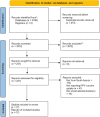Uptake and determinants of HPV vaccination in South Asia: a systematic review and meta-analysis
- PMID: 39722717
- PMCID: PMC11668735
- DOI: 10.3389/fpubh.2024.1453704
Uptake and determinants of HPV vaccination in South Asia: a systematic review and meta-analysis
Abstract
Background: Cervical cancer burden in South Asia is among the highest globally. Due to the lack of national immunization programs, the prevalence of human papillomavirus (HPV) infection and vaccine uptake remains unknown. This systematic review and meta-analysis aim to determine the prevalence of HPV vaccine uptake in South Asia.
Methods: We conducted a comprehensive search of MEDLINE (via PubMed), Embase, the Cochrane Library, and the Web of Science, covering the period from inception to May 20, 2024. We included observational studies reporting HPV vaccine uptake in South Asia, without any language filters or restrictions. The search strategy involved MeSH terms and relevant keywords related to "Papillomavirus Infections," "Vaccination," and "Uptake." MetaXL and STATA were used to perform a proportional meta-analysis and meta-regression analysis.
Results: Out of 3,913 articles identified, 17 articles (10,585 participants) were included in the systematic review. The pooled prevalence of vaccine uptake was 8% (95% CI 1-21). There was high heterogeneity between studies (I 2 = 100%). The pooled prevalence of adequate knowledge of the HPV vaccine was 41% (95% CI 28-55, I 2 = 99%). The pooled prevalence of a favorable attitude toward the HPV vaccine was 56% (95% CI 47-66, I 2 = 98%). In the univariate meta-regression model, good knowledge significantly predicted HPV vaccine uptake (p = 0.003), while no covariates were found to be significant predictors of attitudes toward HPV vaccine uptake.
Conclusion: The findings of this meta-analysis indicate a low pooled prevalence of HPV vaccine uptake (8%) in South Asian countries. The pooled prevalence of adequate knowledge and a favorable attitude toward the vaccine were 41 and 56%, respectively. In the univariate meta-regression model, knowledge of the HPV vaccine uptake was the only significant predictor of vaccine uptake.
Systematic review registration: Systematic review is registered at Prospero through the link https://www.crd.york.ac.uk/prospero/display_record.php?ID=CRD42024547393.
Keywords: HPV vaccination; South Asia; cervical cancer; meta-analysis; vaccination determinants.
Copyright © 2024 Noreen, Naeem Khalid, Murad, Baig and Khan.
Conflict of interest statement
The authors declare that the research was conducted in the absence of any commercial or financial relationships that could be construed as a potential conflict of interest.
Figures












References
-
- Singh D, Vignat J, Lorenzoni V, Eslahi M, Ginsburg O, Lauby-Secretan B, et al. . Global estimates of incidence and mortality of cervical cancer in 2020: a baseline analysis of the WHO global cervical Cancer elimination initiative. Lancet Glob Health. (2023) 11:e197–206. doi: 10.1016/S2214-109X(22)00501-0, PMID: - DOI - PMC - PubMed
-
- Siokos AG, Siokou-Siova O, Tzafetas I. Correlation between cervical carcinogenesis and tobacco use by sexual partners. Hell J Nucl Med. (2019) 2:184–90. PMID: - PubMed
Publication types
MeSH terms
Substances
LinkOut - more resources
Full Text Sources
Medical

